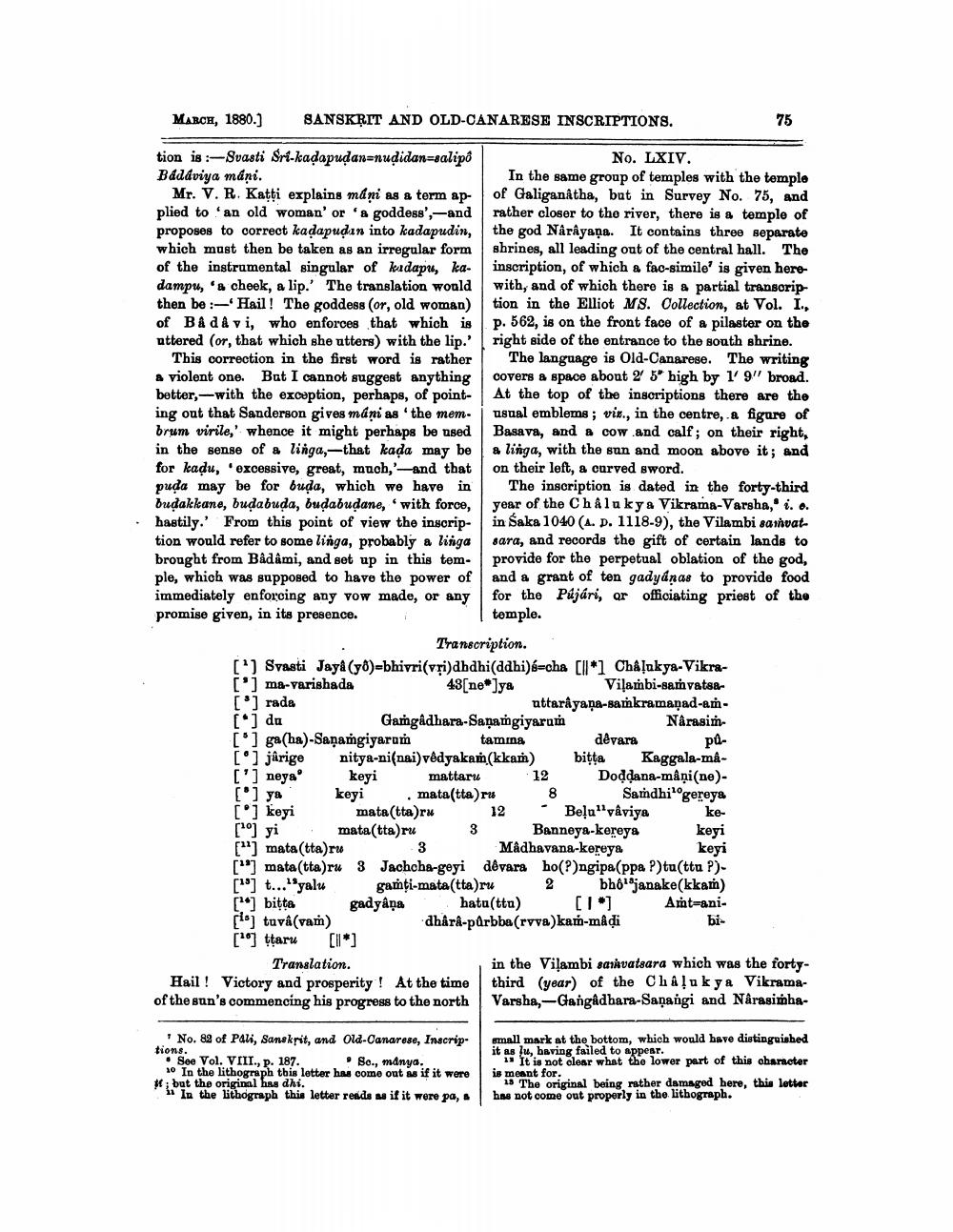________________
MARCH, 1880.)
SANSKRIT AND OLD-CANARESE INSCRIPTIONS.
75
tion is :-Svasti Sri-kadapudan=nudidan=salipo
No. LXIV. Badaviya máni.
In the same group of temples with the temple Mr. V. R. Katti explains mani as a term ap- of Galiganatha, but in Survey No. 75, and plied to an old woman' or 'a goddess',-and rather closer to the river, there is a temple of proposes to correct kadapudın into kadapudin, the god Narayana. It contains three separate which must then be taken as an irregular form shrines, all leading out of the central hall. The of the instrumental singular of kedapu, ka- inscription, of which a fac-simile' is given here dampu, '& cheek, a lip.' The translation would with, and of which there is a partial transcrip then be :-Hail! The goddess (or, old woman) tion in the Elliot Ms. Collection, at Vol. I., of BA a A vi, who enforces that which is p. 562, is on the front face of a pilaster on the uttered (or, that which she utters) with the lip.' right side of the entrance to the south shrine.
This correction in the first word is rather The language is Old-Canarese. The writing a violent one. But I cannot suggest anything covers a space abont 2 5" high by 1'9" broad. better, with the exception, perhaps, of point- At the top of the inscriptions there are the ing out that Sanderson gives máni as 'the mem. i usual emblems; vix., in the centre, a figure of brum virile,' whence it might perhaps be used Basava, and a cow and calf; on their right, in the sense of a linga,-that kada may be a linga, with the sun and moon above it; and for kadu, excessive, great, much,' and that on their left, a curved sword. puda may be for buda, which we have in The inscription is dated in the forty-third budakkane, budabuda, budabudane, with force, year of the Chalu kya Vikrama-Varsha, i.. hastily.' From this point of view the inscrip- in Saka 1040 (A.D. 1118-9), the Vilambi samvattion would refer to some linga, probably a linga sara, and records the gift of certain lands to brought from Bådâmi, and set up in this tem- provide for the perpetual oblation of the god, ple, which was supposed to have the power of and a grant of ten gadydnas to provide food immediately enforcing any vow made, or any for the Pújári, or officiating priest of the promise given, in its presence.
temple.
Transcription. (') Svasti Jaya (78)=bhivri(vri)dbdhi(ddhi)ś=cha [ll*1 Châļukya-Vikra['] ma-varishada
43[ne]ya
Vilambi-samvatsa[°] rada
attarayana-saṁkramaņad-an[ ] da Gamgadhara-Sanaṁgiyaram
Narasim[°] ga(ha)-Sanangiyaram
tamına devara pů[°] jarige nitya-ni(nai) vêdyakan(kkan) bitta Kaggala-ma['] nega keyi mattaru 12 Doddana-måņi(ne)[] ya keyi mata(tta)ru 8 Samdhi gereya [°] keyi mata (tta)ru 12 - Beļa" vâviya ke[1] yi mata(tta)ru 3 Banneya-kereya keyi [^] mata(tta)ru
3 Mâdhavana-kereya
keyi ["] mata(tta)ru 3 Jachcha-geyi dêvara ho(?)ngipa(ppa P)tu(ttu P)[""] t...''yalu gamti-mata (tta)ru 2 bhojanake(kkam) [""] bitta gadyana hatu(ttu) [1] Amt=ani. [') tuvâ(van) dhârâ-pürbba (rvva)kam-måời
bi[*] ttaru [l*] Translation.
in the Vilambi saravatsara which was the fortyHail! Victory and prosperity! At the time third (year) of the Chalu kya Vikramaof the sun's commencing his progress to the north Varsha,-Gangadhara-Sanangi and Narasimha
No. 82 of Pau, Sanskrit, and Old-Canarese, Inscrip tions. ** See Vol. VIII., P. 187. So., manya.
10 In the lithograph this letter has come out as if it were #; but the original has dhi.
ii In the lithograph this letter reads me if it were pa, a
small mark at the bottom, which would have distinguished it as {u, having failed to appear.
11 It is not clear what the lower part of this character is meant for.
13 The original being rather damaged here, this letter has not come out properly in the lithograph.




